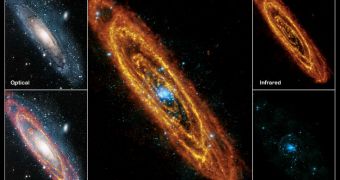Experts with the European Space Agency (ESA) produced one of the most interesting images of our neighboring galaxy, Andromeda, ever taken. Two space telescopes, the Herschel Space Observatory and the XMM Newton, were used to piece together this amazing view.
Herschel, which launched in 2009 aboard the same Ariane 5 heavy-lift delivery system as the Planck mission, captured the most detailed image ever taken of the galaxy in infrared wavelengths.
The ESA observatory is the most complex, and also the largest, space-based instrument ever flown from Earth, and its results prove the worth of its detectors every single day.
Augmenting the quality of the image in IR wavelengths are X-ray data, collected by the ESA X-ray Multi-Mirror Mission – Newton (XMM-Newton) spacecraft, which has been airborne for more than 11 years.
The two space observatories joined forces to image the Andromeda galaxy during the 2010 Christmas season. Their joint results show that our neighbor has more stars than previously established.
Otherwise, it is very similar to the Milky Way, both in terms of size, shape, behavior and number of stars. It is estimated that each of the two galaxies has several hundred billion stars.
According to ESA officials, the new image depicts the strange dust ring encircling Andromeda's galactic circle. The structure itself is some 75,000 light-years across, and astronomers don't yet know how it developed.
Some experts say that a merger with another galaxy in the formation's recent past may have been responsible for the development of the ring. But the Herschel studies bring something new to the table.
The observatory reveals the existence of at least five concentric rings of star-forming dust around the galaxy's core, a discovery that changes the nature of the mystery considerably.
“Both the infrared and X-ray images show information that is impossible to collect from the ground because these wavelengths are absorbed by Earth’s atmosphere,” ESA experts say.
“The twinkling starlight seen from Earth is indeed a beautiful sight but in reality contains less than half the story. Visible light shows us the adult stars, whereas infrared gives us the youngsters and X-rays show those in their death throes,” they add in a press release.
Future studies with Herschel, and the planned NASA James Webb Space Telescope (JWST) will undoubtedly shed more light on the phenomena dictating Andromeda's shape and structure.

 14 DAY TRIAL //
14 DAY TRIAL //